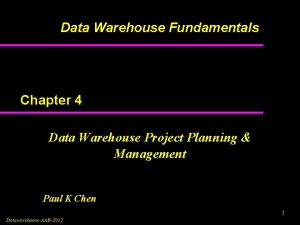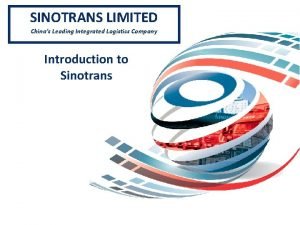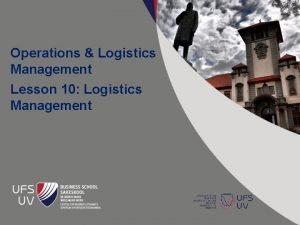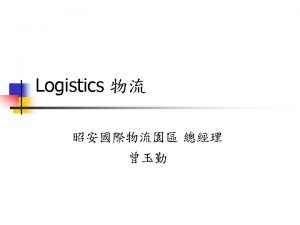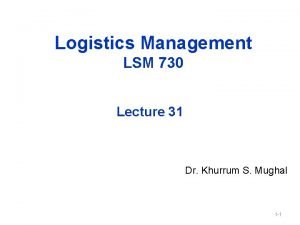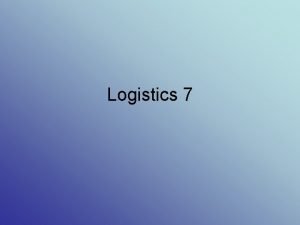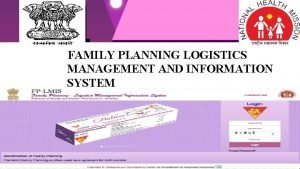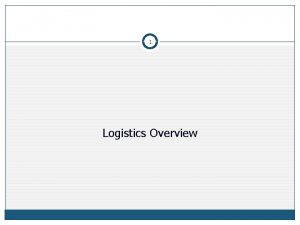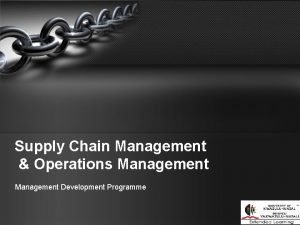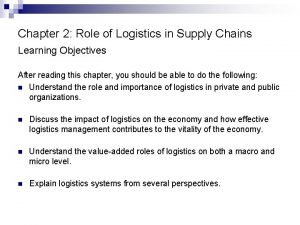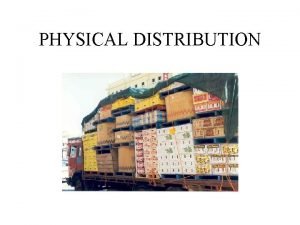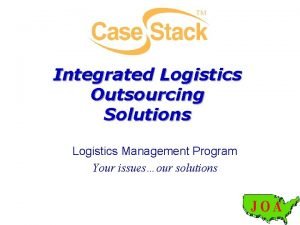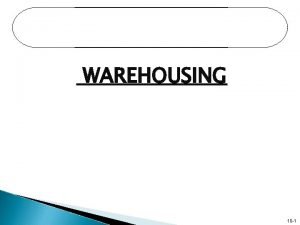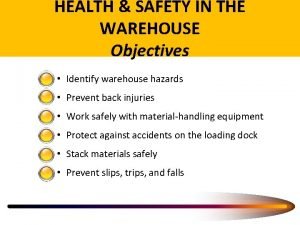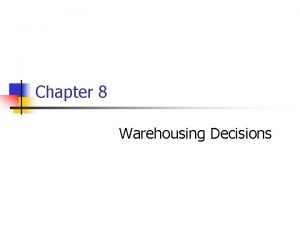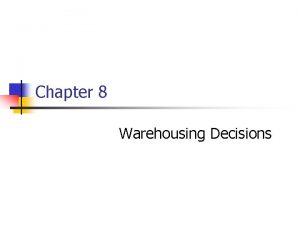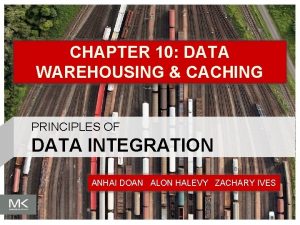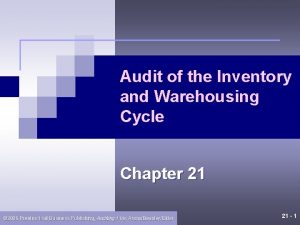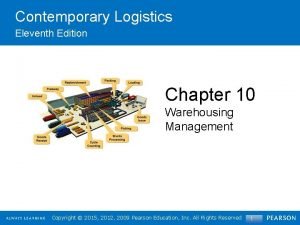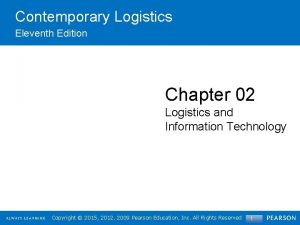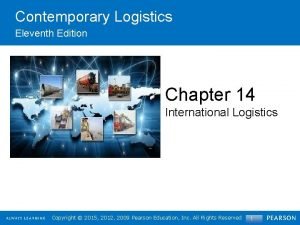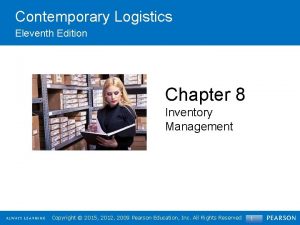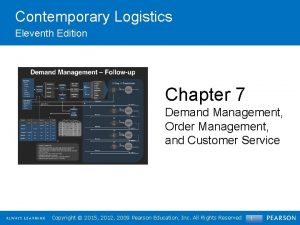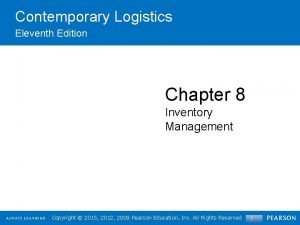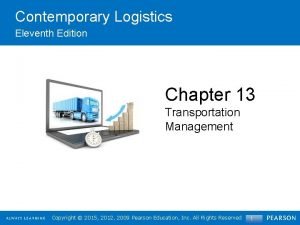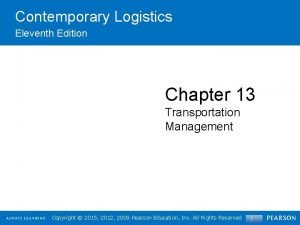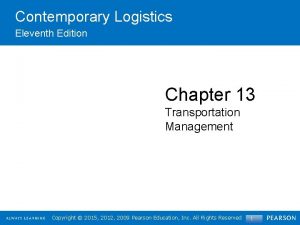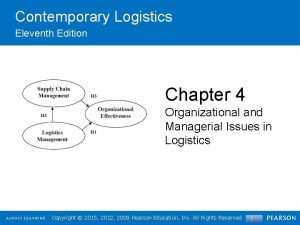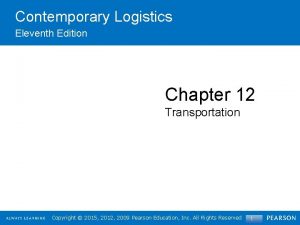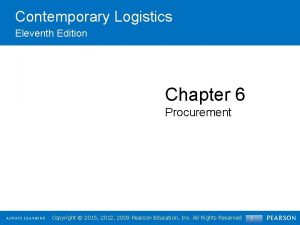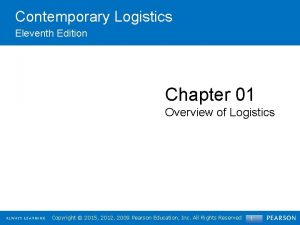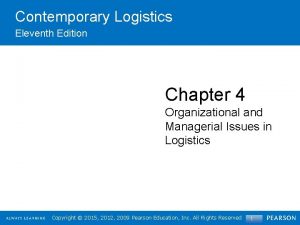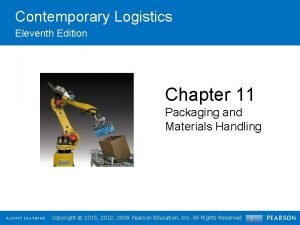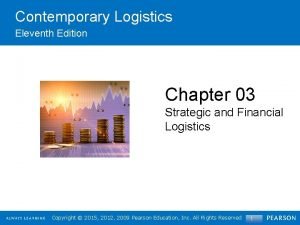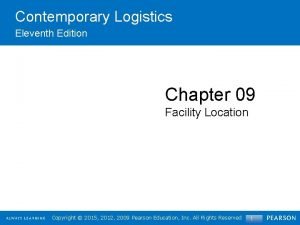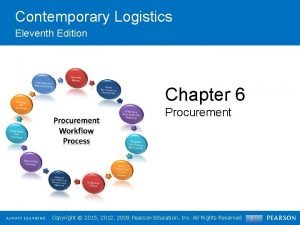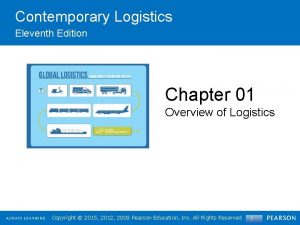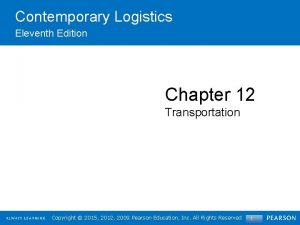Contemporary Logistics Eleventh Edition Chapter 10 Warehousing Management














































- Slides: 46

Contemporary Logistics Eleventh Edition Chapter 10 Warehousing Management Copyright©© 2015, 2012, 2009 Pearson. Education, Inc. All. Rights. Reserved Copyright 1

Learning Objectives • To discuss the role of warehousing in a logistics system • To learn about public, private, contract and multiclient warehousing • To analyze select considerations when designing warehousing facilities • To examine some prominent operational issues in warehousing Copyright © 2015, 2012, 2009 Pearson Education, Inc. All Rights Reserved 2

3 Overview of Class • Chapter 10 • Due: Extra Credit: Six Sigma • In-Class Activities (seen on pwpt) – Participation Copyright © 2015, 2012, 2009 Pearson Education, Inc. All Rights Reserved 3

News and Books • Supply Chain Minded • Good Read: " • Warehouses are an integral part of the modern supply chain, involved in sourcing, producing and distributing goods. However, due to the complexities of warehouse operations they can often be one of the most costly parts of the supply chain. Their efficient management is therefore critical for minimizing cost and contributing to an effective and efficient supply chain. 2015 Cengage Learning Copyright © 2015, 2012, 2009 Pearson©Education, Inc. All Rights Reserved 4

Warehousing Management Key Terms (1 of 3) • Accumulating (bulk making) • Allocating (bulk breaking) • Assorting • Contract (third-party) warehousing • Cross-docking • Distribution center • Dunnage Copyright © 2015, 2012, 2009 Pearson Education, Inc. All Rights Reserved 5

Warehousing Management Key Terms (2 of 3) • Fixed slot location • Hazardous materials • Multiclient warehousing • Occupational Safety and Health Administration (OSHA) • Private warehousing • Public warehousing • Regrouping function Copyright © 2015, 2012, 2009 Pearson Education, Inc. All Rights Reserved 6

Warehousing Management Key Terms (3 of 3) • Sorting out • Throughput • Variable slot location • Warehouse automation • Warehousing Copyright © 2015, 2012, 2009 Pearson Education, Inc. All Rights Reserved 7

The Role of Warehousing in a Logistics System • Warehousing • refers to “that part of the firm’s logistics system that stores products (raw materials, part, good-in-process, finished goods) at an between points of origin and point of consumption. ” Source: Douglas M. Lambert, James R. Stock, and Lisa M. Ellram, Fundamentals of Logistics Management (New York: Irwin Mc. Graw-Hill, 1998), Chapter 8. Copyright © 2015, 2012, 2009 Pearson Education, Inc. All Rights Reserved 8

Warehousing Management • Warehousing and transportation are substitutes for each other, with warehousing having been referred to as “transportation at zero miles per hour. ” Copyright © 2015, 2012, 2009 Pearson Education, Inc. All Rights Reserved 9

The Role of Warehousing in a Logistics System FIGURE 10. 1 Adding a Warehousing Facility: Shorter-Haul Transportation Copyright © 2015, 2012, 2009 Pearson Education, Inc. All Rights Reserved 10

The Role of Warehousing in a Logistics System (1 of 7) • Key reason for warehousing • because patterns of production and consumption do not coincide • Warehousing • serves to match different rates or volumes of flow when patterns of production and consumption do not coincide Copyright © 2015, 2012, 2009 Pearson Education, Inc. All Rights Reserved 11

The Role of Warehousing in a Logistics System (2 of 7) • Warehousing facilitates the regrouping function in a supply chain • Involves rearranging the quantities and assortment of products as they move through the supply chain Copyright © 2015, 2012, 2009 Pearson Education, Inc. All Rights Reserved 12

The Role of Warehousing in a Logistics System (3 of 7) • Warehousing facilitates the regrouping function in a supply chain – can take place in four forms • Accumulating (bulk making) • involves bringing together similar stocks from different sources • Allocating (bulk breaking) • involves breaking larger quantities into smaller quantities • Assorting • refers to building up a variety of different products for resale to particular customers Copyright © 2015, 2012, 2009 Pearson Education, Inc. All Rights Reserved 13

The Role of Warehousing in a Logistics System (4 of 7) • Sorting out • “separating products into grades and qualities desired by different target markets” 1 1 William D. Perreault, Jr. , Joseph P. Cannon, and E. Jerome Mc. Carthy, Basic Marketing, 16 th ed. (New York: Mc. Graw-Hill Irwin, 2008), Chapter 11. Copyright © 2015, 2012, 2009 Pearson Education, Inc. All Rights Reserved 14

The Role of Warehousing in a Logistics System (5 of 7) • Warehousing can be provided by • Warehouses • Emphasize the storage of products • Primary purpose is to maximize the usage of available storage space • Distribution centers • Emphasize rapid movement of products through the facility • Attempt to maximize throughput • Throughput is defined as the amount of product entering and leaving a facility in a given time period Copyright © 2015, 2012, 2009 Pearson Education, Inc. All Rights Reserved 15

The Role of Warehousing in a Logistics System (6 of 7) • Warehousing can be provided by • Cross-docking facilities • Has grown due to the increased emphasis on time reduction in supply chains • Defined as “the process of receiving product and shipping it out the same day or overnight without putting it into storage” 1 • Key benefits include improved service by allowing products to reach their destinations more quickly as well as reduced inventory carrying costs from less stock because of faster product delivery 2 1 No author, “ 2008 Cross-Docking Trends Report, ” Saddle Creek Corporation, 2008. 2 Mike Del. Boro, “Cross-Docking Rediscovered, ” Material Handling & Logistics, May 2011, 34– 37. Copyright © 2015, 2012, 2009 Pearson Education, Inc. All Rights Reserved 16

The Role of Warehousing in a Logistics System (7 of 7) • Warehousing can be provided by • Cross-docking facilities • Is differentiated from distribution centers by the length of time a product is in a facility (24 hours or less for cross-docking facility) • Design of the facility is an important consideration to facilitate quick movement of product • Should be designed with a minimal amount of storage space and truck doors on two or more sides 1 • Some designs include “H”, “I”, “T”, “U” and “E” configurations 1 Del. Boro, “Cross-Docking Rediscovered. ” Copyright © 2015, 2012, 2009 Pearson Education, Inc. All Rights Reserved 17

The Role of Warehousing in a Logistics System FIGURE 10. 2 Ideal Facility for Pure Supplier Consolidation (Full Pallet Movement) Source: Reprinted by permission of the Warehousing Education and Research Council. Copyright © 2015, 2012, 2009 Pearson Education, Inc. All Rights Reserved 18

Public, Private, Contract, and Multiclient Warehousing (1 of 10) • Organizations must also decide the proper mix in terms of warehouse ownership • Owning • Private warehousing • Renting • Public warehousing • Contract warehousing • Multiclient warehousing Copyright © 2015, 2012, 2009 Pearson Education, Inc. All Rights Reserved 19

Public, Private, Contract, and Multiclient Warehousing (2 of 10) • Public warehouses • Serve all legitimate users • Require no capital investment on the user’s part • Allows users to rent space as needed • Can be rented on a month-to-month basis • Warehousing companies have responsibility for personnel decisions and regulatory issues • Offers more locational flexibility • May provide specialized services Copyright © 2015, 2012, 2009 Pearson Education, Inc. All Rights Reserved 20

Public, Private, Contract, and Multiclient Warehousing (3 of 10) • Potential drawback of public warehouses • Lack of control by the user • Warehousing labor safety practices monitored by Occupational Safety and Health Administration (OSHA) Copyright © 2015, 2012, 2009 Pearson Education, Inc. All Rights Reserved 21

Public, Private, Contract, and Multiclient Warehousing (4 of 10) • Private warehousing • Owned by the firm storing goods in the facility • Generates high fixed costs • Should only be considered by companies dealing with large volumes of inventory • Largest uses of private warehousing are retail chain stores • Offers control to owner • Assumes both sufficient demand volume and stability so that warehouse remains full Copyright © 2015, 2012, 2009 Pearson Education, Inc. All Rights Reserved 22

Public, Private, Contract, and Multiclient Warehousing (5 of 10) • Private warehousing potential drawbacks • High fixed cost of private storage • Necessity of having high and steady demand volumes • Less attractive when interest rates are high • May reduce an organization’s flexibility • Internally • Externally Copyright © 2015, 2012, 2009 Pearson Education, Inc. All Rights Reserved 23

Public, Private, Contract, and Multiclient Warehousing (6 of 10) • Contract warehousing • Also referred to as third-party (3 PL) warehousing or dedicated warehousing • “a long term, mutually beneficial arrangement which provides unique and specially tailored warehousing and logistics services exclusively to one client, where the vendor and client share the risks associated with the operation. ” 1 1 Warehousing Education and Research Council, Contract Warehousing: How It Works and How to Make It Work Effectively (Oak Brook, IL: Author, 1993). Copyright © 2015, 2012, 2009 Pearson Education, Inc. All Rights Reserved 24

Public, Private, Contract, and Multiclient Warehousing (7 of 10) • Contract warehousing • Both vendor and client share the risks associated with the warehousing • Less costly than private warehousing and more costly than public warehousing Copyright © 2015, 2012, 2009 Pearson Education, Inc. All Rights Reserved 25

Public, Private, Contract, and Multiclient Warehousing (8 of 10) • Contract warehousing has evolved to include valueadding services to a greater degree than public warehousing 1 • Customization • Reverse logistics • Repair and refurbishment 1 William Hoffman, “Contract Warehousing Evolves, ” Traffic World, January 31, 2005, 16. Copyright © 2015, 2012, 2009 Pearson Education, Inc. All Rights Reserved 26

Public, Private, Contract, and Multiclient Warehousing (9 of 10) • Multiclient warehousing • Mixes attributes of contract and public warehouses • Services are more differentiated than those in a public facility • Services are less customized than those in a contract facility • Services are purchased through minimum 1 year contracts • Are attractive to smaller organizations Copyright © 2015, 2012, 2009 Pearson Education, Inc. All Rights Reserved 27

Public, Private, Contract, and Multiclient Warehousing (10 of 10) • Multiclient warehousing • Are attractive to smaller organizations that don’t have sufficient volumes to: • Build their own storage facilities • Use traditional one client contract warehousing services 1 1 William Hoffman, “Dividing the Box, ” Journal of Commerce, February 25, 2008, 23. Copyright © 2015, 2012, 2009 Pearson Education, Inc. All Rights Reserved 28

Design Considerations in Warehousing (1 of 7) • General considerations • Quantity and character of goods to be handled must be known—product profiling • Know the purpose to be served • Facility with low rates of product turnover should be laid out in a manner that maximizes utilization of the cubic capacity of the storage facility • Facility that emphasizes rapid product movement with limited time in storage should be configured to facilitate the flow of product into and out of it Copyright © 2015, 2012, 2009 Pearson Education, Inc. All Rights Reserved 29

Design Considerations in Warehousing (2 of 7) • Trade-offs • Must be made among space, labor, and mechanization with respect to warehouse design • Fixed versus variable slot locations for merchandise • In fixed slot locations each SKU has one or more permanent slots assigned to it • Variable slot location involves empty storage slots being assigned to incoming products based on space availability Copyright © 2015, 2012, 2009 Pearson Education, Inc. All Rights Reserved 30

Design Considerations in Warehousing (3 of 7) • Trade-offs • Build out (horizontal) versus build up (vertical) • General rule of thumb is that it is cheaper to build up than build out • Illustrates the importance of understanding interfunctional tradeoffs when thinking about warehousing design Copyright © 2015, 2012, 2009 Pearson Education, Inc. All Rights Reserved 31

Design Considerations in Warehousing (4 of 7) • Trade-offs • Order-picking versus stock-replenishing functions • Organizations must decide whether workers who pick outgoing orders and those who are restocking storage facilities should work at the same time or in the same area • Two-dock versus single-dock layout • generally has receiving docks on one side of a facility and shipping docks on the other side, with goods moving between them • In single-dock system, each and every dock can be used for both shipping and receiving Copyright © 2015, 2012, 2009 Pearson Education, Inc. All Rights Reserved 32

Design Considerations in Warehousing (5 of 7) • Trade-offs • Conventional, narrow, or very narrow aisles • As aisle space increases, storage space decreases • Easier to operate mechanical equipment in wider aisles • Reduce the chances of accidents and product damage with wider aisles • Narrower aisles require specialized storage and handling equipment (more expensive) Copyright © 2015, 2012, 2009 Pearson Education, Inc. All Rights Reserved 33

Design Considerations in Warehousing (6 of 7) • Trade-offs • Degree of warehouse automation • Refers to utilizing mechanical or electronic devices to substitute for human labor • Examples include narrow aisle forklifts, automated guided vehicles, automated storage and retrieval systems, and radio frequency identification, and others • Offers the potential to reduce labor costs and to improve warehouse productivity • Managers must ensure that automation results in noticeable improvement in warehousing effectiveness and efficiency Copyright © 2015, 2012, 2009 Pearson Education, Inc. All Rights Reserved 34

Design Considerations in Warehousing (7 of 7) • Trade-offs • Other space needs • Only approximately 10 percent of a facility’s cubic capacity is actually occupied by product 1 • Warehousing facilities set aside space for nonstorage activities such as employee washrooms, lunchrooms, office space, specialized storage for hazardous items, warehousing supplies, and many more Copyright © 2015, 2012, 2009 Pearson Education, Inc. All Rights Reserved 35

Warehousing Operations (1 of 10) • Efficient and effective warehousing management can be an exacting task • Workforce motivation can be difficult because the work can be: • Repetitive in nature • Strenuous and physically demanding • On occasion dangerous Copyright © 2015, 2012, 2009 Pearson Education, Inc. All Rights Reserved 36

Warehousing Operations (2 of 10) • Some prominent operational issues include: • Warehousing productivity analysis • Safety considerations • Hazardous materials • Warehousing security • Cleanliness and sanitation issues Copyright © 2015, 2012, 2009 Pearson Education, Inc. All Rights Reserved 37

Warehousing Operations (3 of 10) • Warehousing productivity analysis • Productivity is a measure of output/input • Numerous productivity metrics can be used to assess warehouse productivity, but not all are relevant to all facilities • Examples of representative measures include: • Cases shipped person • Product lines shipped person • Pallets shipped person • Average warehouse capacity used • Forklift capacity used Copyright © 2015, 2012, 2009 Pearson Education, Inc. All Rights Reserved 38

Warehousing Operations (4 of 10) • Safety considerations • Warehouses, distribution centers, and cross-docking facilities can be dangerous workplaces • Fatality rate in warehousing is higher than the average rate for all industries 1 • Warehouse safety can by influenced by governmental regulations • In the U. S. safety standards have been set for warehousing equipment and operations and are enforced by OSHA 1 Tommie Jones, “Warehousing & Storage Safety: Establishing a Comprehensive Safety Approach, ” Professional Safety, June 2010, 34– 36. Copyright © 2015, 2012, 2009 Pearson Education, Inc. All Rights Reserved 39

Warehousing Operations (5 of 10) • Safety considerations • Warehouse safety categories include: • Employee • Property • Motor vehicles Copyright © 2015, 2012, 2009 Pearson Education, Inc. All Rights Reserved 40

Warehousing Operations (6 of 10) FIGURE 10. 3 Workplace Safety Issues Source: Reprinted with permission of Liberty Research Institute for Safety, August 30, 2012. Copyright © 2015, 2012, 2009 Pearson Education, Inc. All Rights Reserved 41

Warehousing Operations (7 of 10) • Hazardous materials “hazmat” • Examples include: • Explosives • Flammable liquids • Flammable solids • Government regulations often require shipping documents indicating the hazardous materials • Government regulations require the use of safety data sheets (SDS) Copyright © 2015, 2012, 2009 Pearson Education, Inc. All Rights Reserved 42

Warehousing Operations (8 of 10) • Warehousing security • Example potential threats include: • Theft • Pilferage • Heat and humidity • Vandalism • Fire • Loss of electricity • Focuses on protecting products and preventing their theft Copyright © 2015, 2012, 2009 Pearson Education, Inc. All Rights Reserved 43

Warehousing Operations (9 of 10) TABLE 10. 1 Possible Shortcomings in Warehousing Security Shortcoming Comment Reluctance to pursue criminal charges against offending personnel Fewer than 5 percent who commit crimes are prosecuted Ineffective security tools Security cameras aren’t always turned on Laissez-faire attitude toward theft Don’t wait until theft reaches an “unacceptable” level Minimal (or no) penalties for on-the-job substance abuse Approximately 90 percent of drug users either steal or deal to support their habit Infrequent auditing of order checkers’ performance They may become complacent Institutional roadblocks to reporting theft and substance abuse Outsourcing the reporting may be more effective Hiring personnel who are predisposed to theft An ounce of prevention is worth a pound of cure Source: Julia Kuzeljevich, “The SEVEN DEADLY SINS in Warehouse Security, ” Canadian Transportation & Logistics, April 2006, 44. Copyright © 2015, 2012, 2009 Pearson Education, Inc. All Rights Reserved 44

Warehousing Operations (10 of 10) • Cleanliness and sanitation issues • Particularly important in many industries, such the foodservice industry • Can have a positive impact on employee safety, morale, and productivity while also reducing employee turnover 1 • Requires common sense and due diligence 1 Ned Bauhof, “Keeping It Clean, ” Beverage World, July 2007, 77. Copyright © 2015, 2012, 2009 Pearson Education, Inc. All Rights Reserved 45

46 Next Week • Chapter 11 Copyright © 2015, 2012, 2009 Pearson Education, Inc. All Rights Reserved 46
 Management eleventh edition stephen p robbins
Management eleventh edition stephen p robbins Eleventh edition management
Eleventh edition management Management eleventh edition
Management eleventh edition Management eleventh edition
Management eleventh edition Bhore committee
Bhore committee Eleventh 5 year plan
Eleventh 5 year plan 11th five year plan
11th five year plan For his eleventh birthday elvis presley
For his eleventh birthday elvis presley Log 470
Log 470 Data warehouse project charter
Data warehouse project charter Mis chapter 6
Mis chapter 6 Using mis (10th edition) 10th edition
Using mis (10th edition) 10th edition Management stephen p. robbins
Management stephen p. robbins Army logistics management college
Army logistics management college Us army logistics management college
Us army logistics management college Performance cycle uncertainty
Performance cycle uncertainty Integrated logistics management
Integrated logistics management Logistics management introduction
Logistics management introduction Council of logistics management
Council of logistics management Logistics strategy triangle
Logistics strategy triangle Objectives of logistics management
Objectives of logistics management Fplmis gujarat
Fplmis gujarat Types of e crm
Types of e crm Objectives of logistics management
Objectives of logistics management Difference between logistics and supply chain
Difference between logistics and supply chain Logistics and channel management
Logistics and channel management Mmog self assessment form
Mmog self assessment form Supply chain development programme
Supply chain development programme Role of logistics management
Role of logistics management Components of physical distribution
Components of physical distribution What is logistics management
What is logistics management Integrated logistics management
Integrated logistics management Global logistics and supply chain management
Global logistics and supply chain management Objective of warehouse
Objective of warehouse Warehouse ownership arrangements
Warehouse ownership arrangements Introduction to data warehousing
Introduction to data warehousing Oracle data warehouse best practices
Oracle data warehouse best practices Warehouse health and safety requirements
Warehouse health and safety requirements Greenplum data warehousing
Greenplum data warehousing What is kdd process in data mining
What is kdd process in data mining Data warehousing components
Data warehousing components Human thought process
Human thought process Nature of warehousing
Nature of warehousing Basic warehousing decisions
Basic warehousing decisions Principles of data warehouse
Principles of data warehouse Inventory and warehousing cycle
Inventory and warehousing cycle Chicago time
Chicago time









